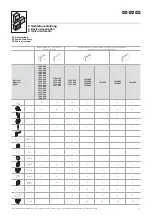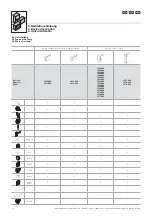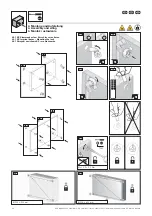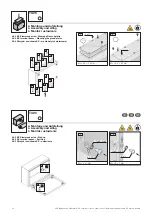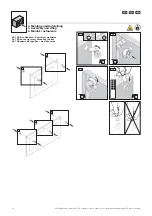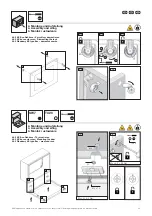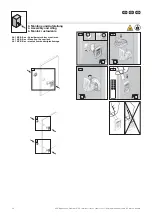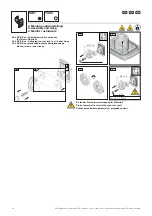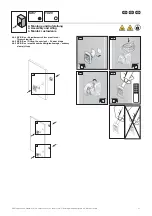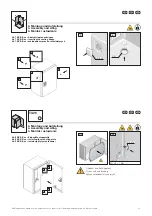
4.1 Anforderungen an den Aufstellort
Vor der Montage ist zu beachten, dass
◾ bei KX KL und KX EB die Umgebungstem-
peratur am Aufstellort nicht höher als +80 °C
und nicht niedriger als –20 °C ist.
◾ bei KX BG die Umgebungstemperatur am
Aufstellort nicht höher als +60 °C und nicht
niedriger als –10 °C ist.
◾ die relative Luftfeuchte 50 % bei +40 °C
nicht übersteigt.
Bei niedrigeren Temperaturen dürfen höhere
Luftfeuchtewerte zugelassen werden, z. B.
90 % r. F. bei +20 °C. Kondensatbildung ist
durch geeignete Maßnahmen zu verhindern.
Liegen besondere Betriebsbedingungen
vor, so müssen besondere Vereinbarungen
zwischen Rittal und dem Anwender getroffen
werden.
Hinweise zur Montage
◾ Halten Sie die auf den Seiten 39 – 44
vorgegebenen Belastungsangaben ein.
◾ Bei der Montage der Gehäuse ist auf eine
ausreichende Ebenheit der Montageflächen
zu achten.
◾ Halten Sie alle vorgegebenen Drehmoment-
angaben ein. Ein Über- bzw. Unterschreiten
der in dieser Anleitung vorgegebenen Anzu-
gsdrehmomente kann zu Anlagenschäden
oder zu schweren bis hin zu tödlichen
Verletzungen führen.
◾ Vermeiden Sie nicht notwendige Öffnungen
am Schaltschrank. Jede eingebrachte und
nicht sorgfältig abgedichtete Öffnung kann
zu einer Reduzierung der Schutzart führen.
◾ Die bestückte Montageplatte ist ggf.
zusätzlich zu ihrer Standardbefestigung für
den Transport zu sichern.
◾ Bei einer Wandmontage ist auf eine aus-
reichende Tragfähigkeit zu achten. Hier sind
auch die Hinweise in der Anleitung des
verwendeten Systemzubehörs zu berücksi-
chtigen.
4.1 Site requirements
Prior to assembly, ensure that
◾ for KX KL and KX EB, the ambient tempera-
ture at the installation site is not higher than
+80 °C and not lower than –20 °C.
◾ for KX BG, the ambient temperature at the
installation site is not higher than +60 °C and
not lower than –10 °C.
◾ the relative humidity does not exceed 50%
at +40 °C.
Higher humidity levels are permitted at lower
temperatures, e.g. 90% relative humidity at
+20 °C. Suitable measures should be taken
to prevent the formation of condensation.
If particular operating conditions apply, special
agreements must be made between Rittal and
the user.
Assembly instructions
◾ Observe the load capacities specified
on pages 39 – 44.
◾ When installing the enclosures the mounting
surfaces must be sufficiently smooth.
◾ Observe all specified torque values. Over- or
undershooting the tensioning torques speci-
fied in these instructions can cause system
damage, severe injuries or even death.
◾ Avoid any unnecessary openings in the
enclosure. Any opening that is not made
and sealed carefully can reduce the degree
of protection.
◾ The equipped mounting plate must be
secured in addition to its standard securing
for transport.
◾ Ensure adequate carrying capacity for wall
mounting. The notes in the instructions for
the deployed system accessories must also
be observed.
19
KX Kleingehäuse, Stahlblech / KX small enclosures, sheet steel / Obudowy małogabarytowe KX, blacha stalowa
4. Montage und Aufstellung
4. Assembly and siting
4. Montaż i ustawienie
4.1 Wymagania odnośnie miejsca usta-
wienia
Przed montażem należy zwrócić uwagę na
to, aby
◾ w przypadku KX KL i KX EB temperatura
otoczenia w miejscu ustawienia nie była
wyższa niż +80 °C ani niższa niż -20 °C.
◾ w przypadku KX BG temperatura otoczenia
w miejscu ustawienia nie była wyższa niż
+60 °C ani niższa niż -10 °C.
◾ względna wilgotność powietrza otoczenia
nie przekraczała 50% przy maks. tempera-
turze +40°C.
Przy niższych temperaturach dopuszczalna
jest wyższa wilgotność powietrza, np. 90%
przy +20°C. Należy bezwzględnie unikać
kondensacji za pomocą odpowiednich
środków.
Szczególne warunki eksploatacji wymagają
dokonania specjalnych uzgodnień pomiędzy
firmą Rittal a użytkownikiem.
Wskazówki dotyczące montażu
◾ Muszą być zachowane parametry obciąże-
nia podane na stronach 39 – 44.
◾ Podczas instalacji obudowy należy zwra-
cać uwagę na odpowiednie wyrównanie
powierzchni montażowych.
◾ Przestrzegać wszystkich podanych momen-
tów dokręcania. Przekroczenie podanych w
niniejszej instrukcji momentów dokręcania
może prowadzić do uszkodzenia urządzenia,
poważnych obrażeń lub nawet śmierci.
◾ Unikać niepotrzebnych otworów w szafie
sterowniczej. Każdy niestarannie wykonany
i nieprawidłowo uszczelniony otwór może
prowadzić do zredukowania klasy ochrony.
◾ Wyposażoną płytę montażową należy ew.
dodatkowo zabezpieczyć przed transpor-
tem.
◾ W przypadku montażu na ścianie zwrócić
uwagę na wystarczającą nośność. Należy
tutaj także uwzględnić wskazówki zawarte w
instrukcjach użytych akcesoriów systemo-
wych.













